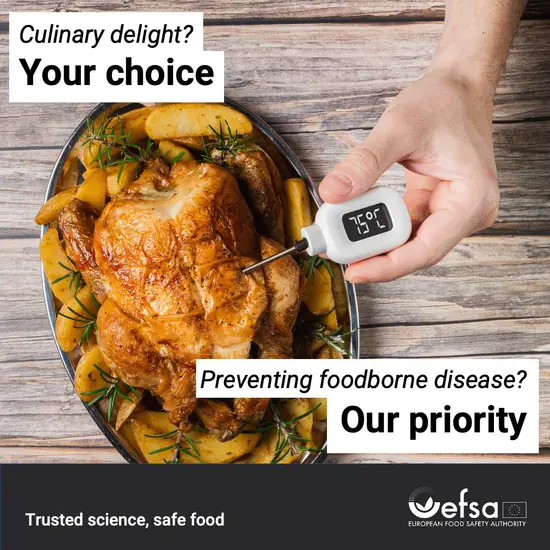Food poisoning
How does it happen and how can I prevent it?
Food poisoning occurs when we eat food contaminated with some harmful bacteria, viruses and parasites. This can happen when:
- Food isn’t cooked or reheated properly.
- It’s handled by someone who hasn’t washed their hands or is feeling unwell.
- Food isn’t stored at the right temperature—such as being left out of the fridge or freezer for too long.
- It’s eaten past its ‘use by’ date.
- Animals or insects come into contact with the food.
Remember, any type of food can cause food poisoning if it’s not handled or stored safely!
Following basic hygiene rules during food preparation is very important. Eggs and meat must be cooked properly to be safely eaten.
Most cases of food poisoning are caused by bacteria from raw food which has come into contact with food that is ready to eat.
What is Salmonella?
Salmonella is a type of bacteria that can cause an illness called salmonellosis in humans. It is a common cause of foodborne disease outbreaks and over 80,000 salmonellosis cases are reported each year in Europe.
In foods, Salmonella ismostly found in eggs and raw meat from chickens, turkeys, and pigs. It can spread to humans through contaminated foods.
Symptoms and risks
Symptoms of human salmonellosis include fever, diarrhoea, and abdominal cramps. If it infects the bloodstream, it can be life-threatening.
How can I prevent it?
Salmonella is killed by proper cooking, but contamination can still occur through improper handling of cooked foods and/or their contact with raw products. To stay safe:
- Cook eggs, poultry, and meat thoroughly to eliminate bacteria.
- Keep raw and cooked foods separate to prevent cross-contamination.
- Use clean utensils, cutting boards, and surfaces for each type of food.
- Wash your hands thoroughly before and during food handling.
- Store perishable foods in the refrigerator below 5°C to slow down or stop bacterial growth.
Simple kitchen habits like these can significantly reduce the risk of salmonellosis.
At home, you can help to prevent Salmonella infection by properly cooking eggs and meat. Following basic hygiene rules when preparing food, such as regular hand washing and keeping raw foods away from cooked products will also reduce risks from foodborne diseases.
Valentina Rizzi, a food microbiologist at EFSA.
European scientists are studying how pathogens like Salmonella contaminate foods such as fruits, vegetables, cereals, and spices. Leafy greens that are eaten raw and vegetables such as onions and asparagus are among the highest-risk combinations.
Through collaboration with EU Member States, the European Commission, EFSA, and ECDC, effective programmes have been implemented to reduce Salmonella contamination in poultry and protect consumers across Europe.
What is Campylobacter?
Campylobacter is one of the most common causes of food poisoning. It is caused by a type of bacteria found in raw or undercooked poultry, unpasteurised milk and untreated water. Even a small amount can cause infection, making proper food handling essential.
Symptoms and Risks
Symptoms typically appear within 2 to 5 days of infection and include diarrhoea (sometimes with blood), stomach cramps, fever, nausea and vomiting. Most people recover within a week, but severe cases can lead to complications especially in young children, older adults or those with weakened immune systems.
How Can I Prevent It?
Campylobacter is killed by proper cooking (temperatures above 75°C), but it can spread through cross-contamination during storage and handling. To reduce your risk of infection:
- Cook poultry thoroughly and ensure it reaches an internal temperature of 75°C. If you don’t own a meat thermometer, you’ll know it’s fully cooked when:
- There's no pink meat remaining when you cut into the thickest part.
- It's piping hot and
- The juices run clear
- Avoid cross-contamination by keeping raw poultry separate from other foods and using different chopping boards and utensils
- Wash hands thoroughly with soap and warm water before and after handling raw meat
- Store raw meat and poultry on the bottom shelf of your fridge in a suitable container to catch any liquid or drips. Do not store above cooked or ready to eat foods in your fridge
- Only consume pasteurised milk and treated water
- Refrigerate raw meat properly (below 5°C) and never wash raw chicken, as this can spread bacteria around your kitchen work surfaces
What is Listeria?
Listeriosis is a serious foodborne illness caused byListeria monocytogenes, a resilient bacterium that thrives in the environment and can even multiply at cold temperatures, such as those in refrigerators. It can contaminate both raw and cooked foods, especially highly processed products like cold cuts, soft cheeses, smoked fish, and ready-to-eat meals.
Although rare, listeriosis is a severe disease with high hospitalisation and mortality rates, particularly affecting vulnerable groups such as pregnant women, newborns, the elderly, and people with weakened immune systems.
Symptoms and risks
Listeriosis symptoms vary, ranging from mild flu-like symptoms such as nausea, vomiting, and diarrhoea to severe complications like meningitis. Protecting against Listeria involves safe food handling, effective refrigeration, and prompt consumption of prepared foods.
How can I prevent it?
Listeria does not survive proper cooking (temperatures above 65°C), but it can contaminate foods again after cooking, during storage, or handling. To reduce your risk:
- Keep your refrigerator below 5°C, as recommended by the World Health Organization, to limit or stop bacterial growth.
- Separate raw, cooked, and ready-to-eat foods during preparation and storage.
- Use clean, dedicated utensils for different types of food.
- Wash your hands thoroughly before and after handling food.
- Consume ready-to-eat foods promptly and avoid consuming perishable food beyond the ‘use by’ date.
Listeria is a tough bacterium that can survive and grow in cold environments, but proper cooking and careful food handling can effectively keep it at bay.
Eleonora Sarno, a food microbiologist at EFSA.































